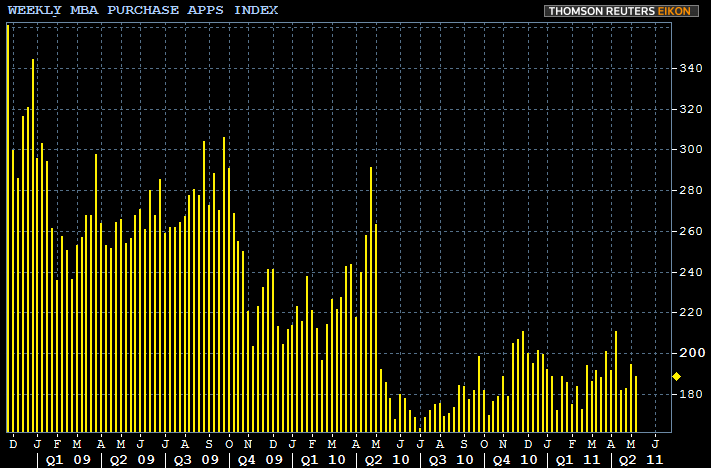This past week brought a spate of poor numbers, highlighted by the decline of -0.3 in the April LEI, only the second decline in 2 years. Housing permits and starts declined, as did existing home sales. Industrial production and capacity utilization also were flat or declined. The Empire State and Philly regional manufacturing reports were also substantially weaker (although both still showed expansion).
Turning to the high-frequency weekly indicators:
Oil finished above $99 a barrel on Friday. It still remains slightly above 4% of GDP. Gas at the pump leveled off for the third week at $3.96 a gallon. Gasoline usage at 9048 M gallons was 0.5% lower than last year's 9092. This YoY comparison has been negative for the last ten weeks in a row, but this week was relatively speaking the best comparison in close to two months.
The BLS reported that Initial jobless claims last week were 409,000. The four week average is now 439, 000. This is the highest 4 week average in half a year, although I expect it to abate in two weeks when the 478,000 weekly number rotates out of the average.
Railfax was up 3.6% YoY. The Baseline traffic 4 week moving average is up 1.07% from a year ago. Cyclical traffic is up 3.55%. Intermodal traffic (a proxy for imports and exports) is 5.11% compared with a year ago. On a 4 week moving average basis, YoY traffic percentage growth is at its low ebb for the last year. On a weekly basis, carloads are up 16,200 or up 2.2%, almost all of it intermodal traffic.
The Mortgage Bankers' Association reported a decrease of 3.2% in seasonally adjusted mortgage applications last week. It was only 1.7% lower than this week last year. Refinancing increased 13.2%, reflecting a decline in mortgage rates. The purchase series has been generally flat for close to one full year - compared with its previous relentless decline, a good thing. This graph from Mortgage News Daily shows that for the first time since the housing bubble burst, we may start to see positive YoY comparisons:

The American Staffing Association Index rose to 94, its second straight week of advancing after 12 weeks at the 90-92 levels. This advance is much like 2007 - slow growth, but not stalled.
The ICSC reported that same store sales for the week of May 14 increased 3.2% YoY, but declined -2.0% week over week. Shoppertrak reported a 8.3% YoY increase for the week ending May 14, and a WoW decrease of 6.8%, reversing last week's pre Mother's day gain. Weekly retail sales numbers have been a bright spot all year, generally showing the consumer not rolling over due to gas prices.
Weekly BAA commercial bond rates increased .01% to 5.83%. This yields of 10 year treasury bond, to the contrary, decreased 0.4% to 3.20%. There is a tinge of fear of deflation in the treasuries, and the slight increase in commercial rates is the first hint of any relative distress in the corporate market.
Adjusting +1.07% due to the 2011 tax compromise, the Daily Treasury Statement showed that for the first 14 days of May 2011, $98.2 B was collected vs. $95.1 B a year ago, for an increase of $3.1 B YoY. For the last 20 days, $130.4 B was collected vs. $127.0 B a year ago, for an increase of $3.4 B, or 2.7%. Use this series with extra caution because the adjustment for the withholding tax compromise is only a best guess, and may be significantly incorrect. Nevertheless the YoY gains have been very tepid in the last month.
M1 was down 0.1% w/w, up 1.7% M/M, and up 12.2% YoY, so Real M1 is up 9.1%. M2 was down 0.1% w/w, up 0.7% M/M and up 5.0% YoY, so Real M2 is up 1.9%. Although Real M1 is still strongly in the "green zone" where it has been since before the end of the "great recession," Real M2 has faded back into the "yellow zone" below 2.5%.
This week's data continued to show YoY weakness in most data. The slowdown is here. The price of Oil and the amount of fiscal fiscal constriction will determine the severity and length of the weakness.